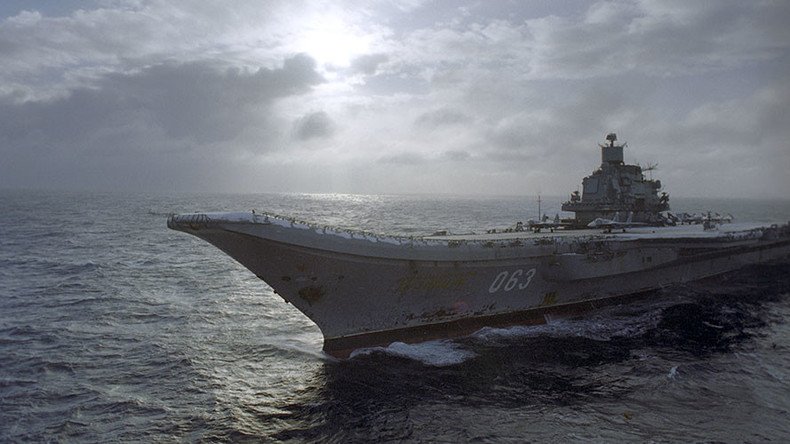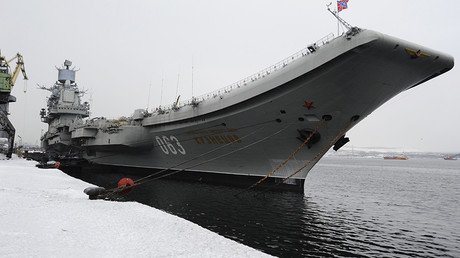Overreaction? Russia’s air carrier group tour to Med provokes military, media hysteria in Europe

A cruise of the Russian Northern Fleet’s naval group, including Russia’s only aircraft carrier, to the Mediterranean Sea has provoked a nervous response from some European states, who said they could send their vessels to intercept the group.
The Netherlands said that it is ready to send HNLMS Evertsen, a guided-missile frigate of the Dutch Royal Navy, to intercept the Russian air carrier group. The frigate will escort the group as it passes through the Northern Sea, Rob Verkerk, the Dutch Royal Navy Commander, said in his Twitter post.
ZrMs Evertsen stand-by om Kuznetsov-groep eventueel te escorteren in geval van passage door Noordzee. pic.twitter.com/gNa21wXPU5
— Rob Verkerk (@GeneraalVerkerk) October 19, 2016
Verkerk later added that the Admiral Benelux, the Commanding Officer of the combined military staff of the Royal Netherlands Navy and the Naval Component of the Belgian Armed Forces, will also send Belgian frigate, Leopold I, to join the escort mission.
Standing NATO Maritime Group met als ABNL-bijdrage BNS Leopold I getasked op Kuznetsov-groep. Inzet ETVN niet nodig. pic.twitter.com/bHTWZpqD4V
— Rob Verkerk (@GeneraalVerkerk) October 19, 2016
The Russian naval group headed by Admiral Kuznetsov, Russia’s only aircraft carrier, left the port of Severomorsk at 3:00 p.m. Moscow time (12 noon GMT) on October 15 for the eastern Mediterranean. It also includes the battle cruiser Peter the Great, the anti-submarine vessel Severomorsk, and five other vessels of Russia’s Northern Fleet.
The group is now conducting three-day exercises in the Northern Sea 170 nautical miles (273 kilometers) away from the Norwegian coast. The drills involve practice flights of the carrier’s aircraft. The exercises were closely monitored by the HNoMS Fridtjof Nansen, a frigate of the Norwegian navy, RIA Novosti reports.
In the meantime, Norwegian media outlet VG.no called the Russian naval group’s cruise “the biggest demonstration of Russian military power” in recent years.
Sweden also sent its reconnaissance aircraft to monitor the movements of the Russian air carrier group. A Gulfstream 4 recon airplane with the call-sign SVF623 approached the area of the Northern Sea the group was passing through Wednesday, Interfax reported.
Russia has “deployed all of the Northern fleet and much of the Baltic fleet in the largest surface deployment since the end of the Cold War,” Reuters reported, referring to the group that includes only a part of the Russian Northern Fleet and citing an unnamed senior NATO diplomat.
On October 15, British media reported that the UK Royal Navy had readied the HMS Duncan, a Type 45 destroyer, and HMS Richmond, a Type 23 frigate, to intercept the Russian vessels should they approach British waters, as it is expected that the air carrier group will pass through the English Channel on its way to the Mediterranean.
An RAF Rivet Joint spy plane, C130 Hercules and Typhoon jets were also reportedly on standby.
Meanwhile, coverage of the drills in the British press could at best be described as sensationalist. Some media outlets even speculated that the ships could take part in the Russian military operation in Syria.
The Russian Navy has not confirmed having any battle missions in the Middle East. The group will “ensure a naval presence in operationally significant areas of the world’s oceans,” the Russian Navy said in an official press release, adding that “particular attention will be paid to ensuring the safety of maritime navigation and other maritime economic activities of the Russian Federation, as well as respond to new types of modern threats such as piracy and international terrorism.”
The tour of duty comes as relations between Russia and the West have been tense because of the Syrian crisis and the situation in Ukraine.
The decision to send the Admiral Kuznetsov on its latest mission was made in late September, and the tour of duty is expected to last four to five months. The Russian air carrier has previously carried out military operations in the eastern Mediterranean over the last few years, aiding Russian Air Forces battling militants including the Islamic State (IS, formerly ISIS/ISIL) and the Al-Qaeda offshoot Al-Nusra Front in Syria.
Admiral Kuznetsov was commissioned in 1990 and is so far Russia’s only aircraft carrier. Manned by a crew of 1,960 naval personnel, it has Granit anti-ship cruise missiles and as well as Blade and Chestnut gun systems in its arsenal and can transport more than 50 aircraft.













